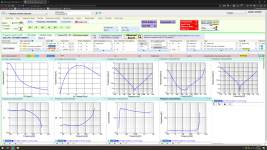Don't get me wrong, I'm not stumping for using these things for anything. I'm just curiously investigating where they can or should not be used for anything.
At this point it looks like the answer is that they can be used in guitar devices. I have them working surprisingly well. The point to doing that relates to them being very small an cheap and electric guitars like the low order distortion anyway. In electric guitar work however the level of THD that these class 2 ceramics generate is usually completely covered up. It's a different world altogether.
Regarding high end audio, I do want to know what the real limits are as I'm not a subjectivist, I'm an engineer and I find the details fascinating. I want to sort out what I can really hear or not. I also want to know what type of component is really necessary to get the job done.
At this point it looks like the answer is that they can be used in guitar devices. I have them working surprisingly well. The point to doing that relates to them being very small an cheap and electric guitars like the low order distortion anyway. In electric guitar work however the level of THD that these class 2 ceramics generate is usually completely covered up. It's a different world altogether.
Regarding high end audio, I do want to know what the real limits are as I'm not a subjectivist, I'm an engineer and I find the details fascinating. I want to sort out what I can really hear or not. I also want to know what type of component is really necessary to get the job done.
Some time ago I thought it would be nice to design a hi-gain guitar pre-amp using MLCCs.
But it was not nice.
I learned the hard way how microphonic these are, making the hole pcb useless.
Since then I am back to Wima foils or electrolytics, at any stage in the audio chain, including power amp input and output filter caps.
But it was not nice.
I learned the hard way how microphonic these are, making the hole pcb useless.
Since then I am back to Wima foils or electrolytics, at any stage in the audio chain, including power amp input and output filter caps.
Wow. There's lotsa 'lytics in there.Here is a photo of my DAC. Notice they used polyester WIMA .1uF as power IC bypass. What do you think of this, if I understand it right, especially for a high speed circuit, maybe NP0 could have been the better choice? Any thoughts on this? Notice below the ladders and power ICs.
View attachment 1321945
MLCCs are a mass product certainly not focusing on the ridiculously tiny hi-end audio section.
For their standard application rf blocking of supply lines non linearity is a minor issue.
And it is documented in the data sheets.
So what is your point?
I've seen many class 2 ceramic capacitor datasheets that don't say anything about the nonlinearity, that actually hardly contain any data at all besides case sizes and ordering codes. If you are lucky, you may then still find information about the nonlinearity and about the performance in general somewhere on the manufacturer's website.
For the higher capacitance values, it's not unusual for the capacitance to drop to one fifth of the original value when you apply the nominal working voltage. That's bad enough to be an issue even when you only want to decouple a supply.
Yes. That's why you need to measure the nonlinearity. Even from the same manufacturer lower voltage class2 ceramic capacitors may actually have more capacitance left than higher voltage caps with same dielectric at same DC.I've seen many class 2 ceramic capacitor datasheets that don't say anything about the nonlinearity, that actually hardly contain any data at all besides case sizes and ordering codes.
Again, Murata's online SimSurfing tool is worth playing with. Here's a screenshot of some graphs for a random 22uF 10V X5R 0603 cap...I'd rather select a manufacturer that does specify it.
Attachments
Leave the 10 uF capacitors in. They give the best THD values. You could increase the 22k resistors to 100k. That is healthier for the frequency response.Considering replacing electrolytics on input with 10uf ceramics. What do you think of that, improvement in sound, further degradation from electrolytic? Suspect lytics are drifting as each other one in this preamp was. Here is a snip from the schematic.
View attachment 1319267
- Home
- Source & Line
- Analog Line Level
- 10uF Ceramic as Electrolytic Replacement
